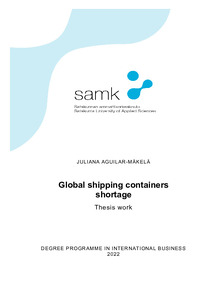Global shipping containers shortage
Aguilar-Mäkelä, Juliana (2022)
Aguilar-Mäkelä, Juliana
2022
All rights reserved. This publication is copyrighted. You may download, display and print it for Your own personal use. Commercial use is prohibited.
Julkaisun pysyvä osoite on
https://urn.fi/URN:NBN:fi:amk-2022101121088
https://urn.fi/URN:NBN:fi:amk-2022101121088
Tiivistelmä
The flow of maritime trade has known since the beginning of the pandemic, a growing and worrying port congestion. Numerous ports throughout the world have seen COVID 19 outbreaks and cargo delays, leading to lengthening wait times and, in some cases, weeks-long lines. Since shipping accounts for more than 80% of global trade, port congestion has had a significant negative influence on supply chains all over the world.
Without a doubt, COVID 19 has created a gap in the global container shortages, which, according to experts, will last for another two years. As a result, the pandemic is not the only issue affecting the container shortage, which is also covered in this thesis.
However, the purpose of this thesis is to analyze the global shipping container shortage using articles, news, books, and interviews with specialists in the field, and then propose solutions to mitigate this disruption using survey data.
The procedure started in March 2022 with the gathering of information, reading of pertinent literature, and creation of the theoretical framework, which was completed in October 2022. a particular interview with Kuehne Nagel, one of the biggest logistics businesses, and observations from several sources to support the data gathered.
Without a doubt, COVID 19 has created a gap in the global container shortages, which, according to experts, will last for another two years. As a result, the pandemic is not the only issue affecting the container shortage, which is also covered in this thesis.
However, the purpose of this thesis is to analyze the global shipping container shortage using articles, news, books, and interviews with specialists in the field, and then propose solutions to mitigate this disruption using survey data.
The procedure started in March 2022 with the gathering of information, reading of pertinent literature, and creation of the theoretical framework, which was completed in October 2022. a particular interview with Kuehne Nagel, one of the biggest logistics businesses, and observations from several sources to support the data gathered.
